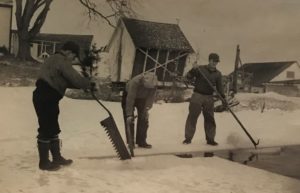Our Waushacum Lakes, valued for the purity of the water, were the source of tons of ice beginning as early as 1870. By 1902, an ice consortium worth more than $16 Million was consolidating smaller ventures into The New England Consolidated Ice Company controlling the principal ice companies of New England. Modelled after Standard Oil, ice was considered a public utility of sorts as it was necessary in every household. A block of ice would last as long as three weeks in an insulated metal ice box. Boston alone required some 90,000 tons of ice per month.

Plows would clear the snow off of the Waushacum Lakes as soon as the ice could handle the horse teams with plows. It was reported that 500,000 tons of ice were removed from the ponds each year. Ice houses stored tons of 12” thick ice blocks. Each block cut from the ponds with a saw, hooked and pulled from the water with tongs and placed on a sled and dragged by horse to the ice house. The houses were owned by the Sterling Inn, C.F. Ward, Patten Brothers, J.W. Fitch, E. Burpee, John Gates, the Providence Ice Company and others. Ice houses populated the shores of both ponds. On West Lake Waushacum, the houses were near the rail line (now the rail trail just west of the bridge) on the Quag. So close to the rail line were these houses, fires occasionally broke out caused by sparks from the passing by locomotives.
Temporary workers were hired for as much as 20 cents per hour to cut the thick cakes of ice and pull them from the freezing water filling the ice houses. In severely cold weather, the Providence Ice Company employed as many as 70 men harvesting as much as 20,000 tons per week. Other workers had more steady employment delivering ice to the neighboring towns and cities by rail.
By 1937, the use of ice had begun to dwindle. Many of the ice houses were leveled and in September, 1937, the Providence Ice House was demolished and the 30 foot long 3” hard pine planks were sold off as scrap by the Shanberg Wrecking Company of Clinton.
